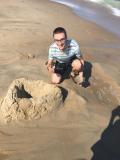Monday, July 29, 2019
By:
Let’s take the Fourier transform of this summer.
For those of you who haven’t gone down the rabbit hole of physics or math far enough to know what that is, let me just say it’s a way to separate a signal into the components that make it up based on their frequency and how strong each one is (its amplitude).
The highest frequency, in the hundreds of kilohertz, is the AC voltage signal which makes the metal lines of my samples visible to the microscope. Below that, around 80 kHz, is the resonant frequency of my .3 N/m cantilever, scanning over the surface and interacting with the tiny static forces that alter the phase of its vibration. The complex electronics directing it operate at a few kilohertz, with feedback loops driving positioning systems with nanometer precision. Moving way down the spectrum, there’s a blip of noise at 60 Hz caused by the frequency of the wall outlet’s power. Things really start to slow down now: every line takes five seconds to scan (0.2 Hz), each scan takes about five minutes (3 mHz), and a full data set is more like an hour (280 µHz).
Zoom way out; make the scale logarithmic. Twice a day (23 µHz) I ride the metro, usually with Nicholas Stubblefield; we do the crossword most days, especially now that we don’t have many left. Every day (11 µHz), I wake up; I load the dishwasher; I shave. I do the things which are literally quotidian, but doing them in our nation’s capital makes them special, somehow. Once per week (1.6 µHz), I come up with another idea for a blog post and find myself sitting right here. And, barely visible at the far left of the spectrum, once per year (31 nHz) I have a birthday.
But some things don’t show up as neatly on the transform’s axis. How do I quantify the frequency of Terry’s SpongeBob references? Or Nicholas’s use of the word “swell”? Or Nolan’s page turns as he works his way through yet another book? These are the little things that get lost in the noise of the baseline of the signal; as with all data processing, sometimes it can be hard to separate the meaningful from the artificial, and yet I can’t help but think that it’s the little things I’ll miss most.[9]
But one very important thing which happened this week was in no way small: the Atlantic Ocean. You’ll forgive a Midwesterner’s misunderstanding of coastal geography, but I thought that as soon as you were on “the East Coast” you were practically at the ocean. Although a five-hour car ride (thank you for driving, Nolan) soon proved me wrong, the five of us who went unanimously agreed that it was worth it as soon as the first waves hit us. For context, I have never been in the ocean when there were any waves to speak of. The sheltered nook of Long Island Sound where I went last year was as flat as my homeland of the Great Plains. These waves, on the other hand, were rolling hills of green, mountain ranges topped with a snow-cap of breaking foam. They were gentle rollers, easily lifting me and setting me down—until I got too close to shore, when a particularly large wave might drive me to my knees in the sand, my world suddenly a blur of bubbles and rushing current. It was exhilarating. Bookend this experience by a road trip with four amazing people, and the result is a perfect day.
Sinusoids, or what most people just call waves, are everywhere around us. The ancients saw waves in the ocean, and sound has been made by waves on a string since the earliest days of music. Photons in the form of radio waves connected people across the nation and the world—first over the AM frequencies, later over Wi-Fi. Sensitive instruments now measure gravitational waves. Where will waves take us next as scientists? But more importantly, where will waves take me? Let me explain.
In one of my favorite books, a character describes the course of her life in a way which I think I’m beginning to relate to—and not just because of my ocean adventures. She says that it’s like facing waves on a stormy sea; each one arrives, tall and imposing, threatening to break upon her. She knows that, even with all her strength, she might not be enough to fully control what happens to her. And yet, she says that is the delight of swimming. I see the future rolling toward me in a similar way. Right now, I’m rushing down the crest of the wave that was this summer; its peak separates me from the seas behind me, and who I was before. In the choppy waters ahead are little challenges, the daily component of this wave spectrum—but some of the waves that are to come are tall enough I can see them a mile off. Does that scare me? I guess I’m still answering that question. But when I look at what I’ve gone through already, I have to agree with the Lady from the book: perhaps the excitement of the unknown is a part of life.
And perhaps the pursuit of the unknown is what this summer has helped me embrace.
Joseph Tibbs






